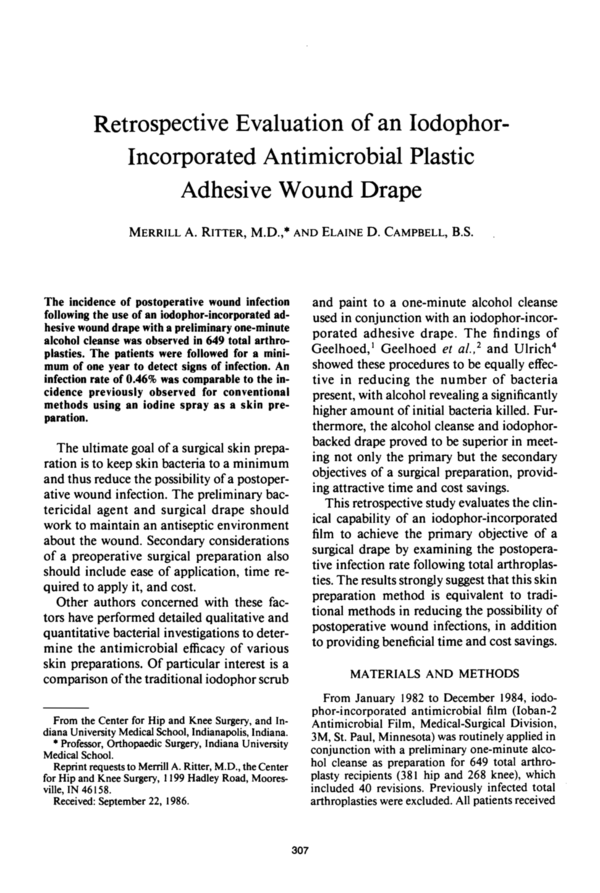Retrospective evaluation of an Iodophor-Incorporated Antimicrobial Plastic Adhesive Wound Drape
Retrospective evaluation of an Iodophor-Incorporated Antimicrobial Plastic Adhesive Wound Drape
Folder:
Year:
Abstract:
The incidence of postoperative wound infection following the use of an iodophor-incorporated adhesive wound drape with a preliminary one-minute alcohol cleanse was observed in 649 total arthroplasties. The patients were followed for a minimum of one year to detect signs of infection. An infection rate of 0.46% was comparable to the incidence previously observed for conventional methods using an iodine spray as a skin preparation.
DOI:
PMID: 3342583
Type of document:
Language:
Retrospective Evaluation of an Iodophor-
Incorporated Antimicrobial Plastic
Adhesive Wound Drape
MERRILL A. RITTER, MD.,' AND ELAINE D. CAMPBELL, BS.
The incidence of postoperative wound infection
following the use of III iodoph ‘Incorporated ud-
liesive wound drape with I prellmlnlry one-minute
Ilcohol cleanse vvls observed in 649 Iotnl arthro-
plasties. The patients were followed for 1 mini-
mum of one year to detect signs of infection. An
infection nte of 0.46% was comparable to the in-
cidence previously observed for collve onal
methods using on iodine spray is a skin pre-
parution.
The ultimate goal of a surgical skin prepa-
ration is to keep skin bacteria to a minimum
and thus reduce the possibility ofa postoper-
ative wound infection. The preliminary bac-
tericidal agent and surgical drape should
work to maintain an antiseptic environment
about the wound. Secondary considerations
of a preoperative surgical preparation also
should include ease of application, time re-
quired to apply it, and cost.
Other authors concemed with these fac-
tors have performed detailed qualitative and
quantitative bacterial investigations to deter-
mine the antimicrobial efficacy of various
skin preparations. Of particular interest is a
comparison of the traditional iodophor scrub
From the Center for HI]: and Knee Surgery, und In-
diana University Medical School, Indianapolis Indiana.
- Professor, Onhopaedic surgery. Indiana University
Medical School.
Reprint requests to Merrill A. Ritler. M.D., the Center
for Hip and Knee surgery. 1199 Hadley Road, Moons-
villc. IN 45153.
Received: September 22. ms.
307
and paint to a one-minute alcohol cleanse
used in conjunction with an iodophor-incor-
porated adhesive drape. The findings of
Geclhoed,‘ Geelhoed er al..’ and Ulrich‘
showed these procedures to be equally effec-
tive in reducing the number of bacteria
present, with alcohol revealing a significantly
higher amount of initial bacteria killed. Fur-
thermore, the alcohol cleanse and iodophor-
backed drape proved to be superior in meet-
ing not only the primary but the secondary
objectives of a surgical preparation, provid-
ing attractive time and cost savings.
This retrospective study evaluates the clin-
ical capability of an iodophor-incorporated
film to achieve the primary objective of a
surgical drape by examining the postopera-
tive infection rate following total arthroplas-
ties. The results strongly suggest that this skin
preparation method is equivalent to tradi-
tional methods in reducing the possibility of
postoperative wound infections, in addition
to providing beneficial time and cost savings.
MATERIALS AND METHODS
From January 1982 to December I984, iodo-
phor-incorporated antimicrobial lilm (Ioban-2
Antimicrobial Film, Medical-Surgical Division,
3M, St. Paul. Minnesota) was routinely applied in
conjunction with a preliminary one-minute alco-
hol cleanse as preparation for 649 total arthro-
plasty recipients (381 hip and 268 knee), which
included 40 revisions. Previously infected total
anhroplasties were excluded. All patients received
308 Ritter and Campbell
ctnat Orlhonlodtcs
and Retltafi mnnrat
4% hours of cephalosporin beginning 30 minutes
before surgery and were operated upon in a hori-
zontal laminar air flow operating room (300 air
changes/hour) without the use of hooded exhaust
equipment.
The patients were followed for a minimum of
one year after surgery to detect any indication of
postoperative infection. An infection consisted of
a draining wound and/or a positive culture from
the joint itself. No cultures were made ofthe skin
at any time during the procedure.
RESU LTS
Of the 649 total arthroplasties performed
using the loban-2 drape. only three infec-
tions (0.46%) were encountered. All three in-
fections were from primary operations. Two
infections were Staphylococcus aureux, one
appearing at two weeks in a total knee
arthroplasty recipient, and the other appear-
ing at five months in a total hip arthroplasty
recipient. The third infection was Staphylo-
coccus epidermidir and was evident 15 days
following a total knee arthroplasty.
DISCUSSION
The results of this study are self-evident.
The plastic iodophor-backed drape, when
used in conjunction with a preliminary alco-
hol cleanse. is an excellent method of surgi-
cal skin preparation. Not only does the easy
preparation method supply suflicient anti-
microbial action at the surgical site."“ but
the application advantage of the drape is not
offset by an elevated infection rate. in fact,
the exceptional postoperative infection rate
of0.46% observed in this study parallels the
rate of 0.42% found in a previous study in-
volving a conventional polymer-iodine spray
as a skin preparation? Furthermore, the
Ioban-2 drape used in this study requires
only a one-minute alcohol cleanse. eliminat-
ing the requirement for a preliminary anti-
septic scrub. thus providing time and cost
advantages without sacrificing sterility.
REFERENCES
1 Geelhoed. G. w.. Preupcrntite skin prr:p1.tr1llIun'
Evaluation of errrcacy. liming. CmIvt‘nrL‘m'C. and
cost. Infections in Surgery 4:648, ms.
2. Geelhoed, 0. w., shnrpe, r
Coments go here:
- Log in to post comments

